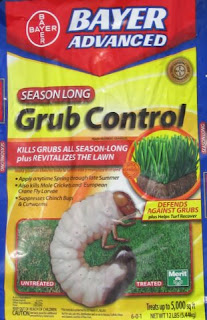 |
| Purple-leaf plum |
Do Japanese beetles eat your purple-leaf plum or Japanese maple tree leaves in early summer?
We moved to Meadow Glenn in January. In late April and early May our two purple-leaf plum trees bloomed and leafed. In June and July, Japanese beetles ate nearly every leaf on the trees, leaving just the veins of the leaves.
Yes, the trees managed to re-leaf, but they were a sorry sight. Then one day, an expert on insect pests lectured to Master Gardeners and in the Q/A time, I raised my hand: “Our purple-leaf plums each year are defoliated by Japanese beetles. Any suggestions?”
The lecturer didn’t hesitate: “After the tree blooms and starts to leaf out, spread a little granular insecticide with imidicloprid under the canopies of the trees. The pesticide is systemic and the beetles won’t eat your leaves.”
Ah, a short answer. The next spring, after the plums flowered, I bought a bag of Grub-Ex. I read the label, which mentioned that the granules killed Japanese beetle grubs but didn’t say anything about protecting tree leaves. Killing grubs under the trees might be great, of course, but certainly that wouldn’t prevent Japanese beetles flying in from untreated areas to dine on our trees.
I had bought the bag of grub-killer, so I decided to try it. I later learned that in addition to killing insect larvae in the soil, imidicloprid is a systemic insecticide that the tree roots take up over several weeks and transport to the leaves. Japanese beetles then refuse to dine on the leaves.
A friend in Virginia also uses imidicloprid granules to protect his Japanese maple, which before treatment was threatened by the insects.
 |
| 0.25% imidicloprid |
The brand I used this month is Bayer Advanced Season Long Grub Control. The 12-pound bag contains 0.25% imidicloprid, and a bag that size is sufficient to protect our two mature plums for four years. The label mentions use on lawns and around trees and shrubs and that it shouldn’t be used in vegetable gardens. It also says the pesticide is “highly toxic to aquatic invertebrates.” Always read pesticide labels completely.
Quick fix? Imidicloprid protects our purple-leaf plums. But what about the bees—and other beneficial insects? I plan to continue monitoring the research, and some day I may decide that the risks of imidicloprid, even the small amounts I use, are too high for the problem it solves.
You can't have it all, Bob, it seems. Your conclusion seems a right way to go. Yes, the risks are high.
ReplyDeleteGood reasoning and yes, let's protect our honey bees.
ReplyDeleteBeetles or insects in any cases come in search of food. Make sure to keep the garbage can out and keep the place and surroundings clean. Regular pest control service will also help.
ReplyDelete